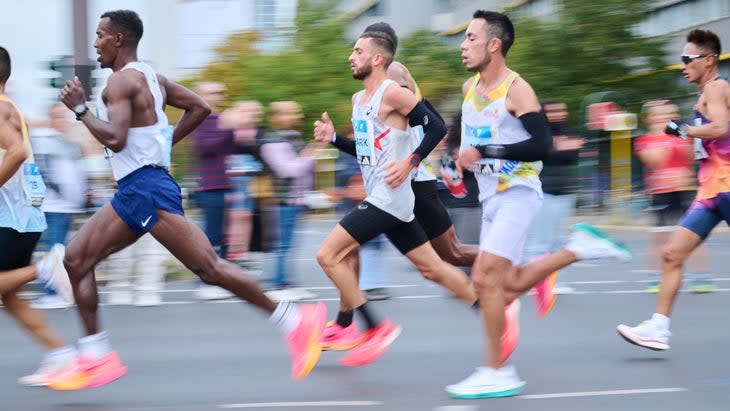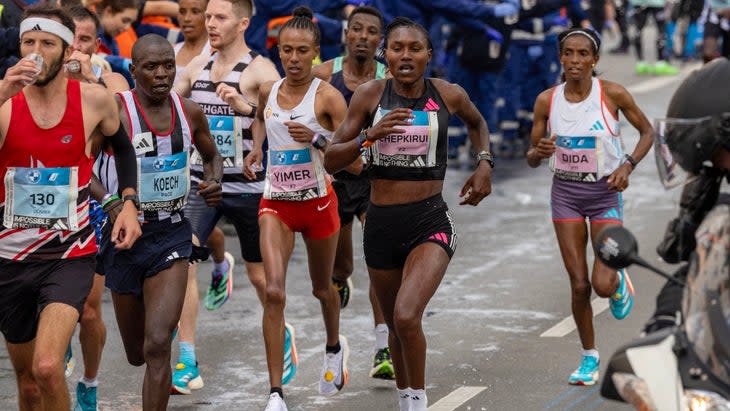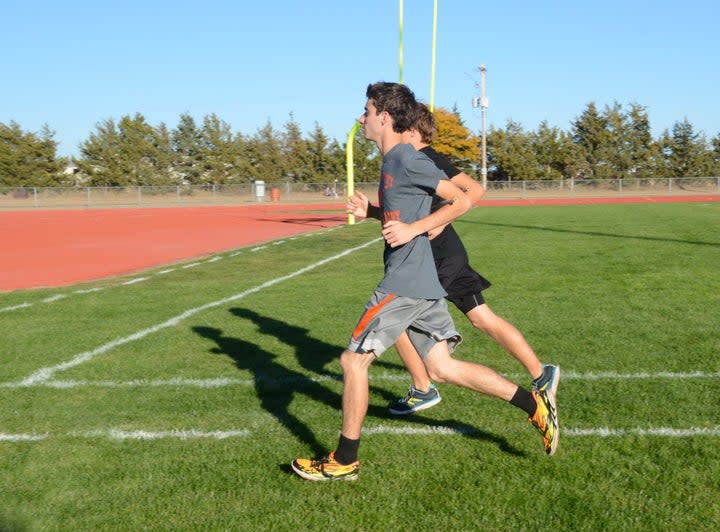Want to Run More Efficiently? Focus on Your Elbows.
This article originally appeared on Outside
Next time you watch a group of elite runners, pay attention to their arms. You'll see that invariably--regardless of how high they carry their arms or what their hands do during the swing--they all drive their elbows far back with each stride. This characteristic of good runners is more universal than any type of footstrike or leg swing mechanics.
Driving your arms backward shifts your balance more upright and forward, so that your feet can land closer beneath your body and push backward. Keeping your arms back also helps ensure that your movement and force all travel in a forward and backward direction; if your arms stay in front of your body, they'll tend to swing back and forth across the midline, misdirecting motion and wasting force in sideways and rotational movements.
Elbows Back
Keeping your arms back can do more for your footstrike than thinking about where your feet are landing. Where and how you land depends largely on the strength, mobility and mechanics of your hips, legs and feet, and, if altered without improving the underlying mechanics, usually ends up creating an unnatural, less-efficient stride.
Your arms, however, are not weight-bearing, so their movement can be more easily modified. They do, however, affect balance and cadence, and subconsciously influence what your legs and feet do. Thus, many who work with runners on their stride increasingly are finding cuing arms the most effective way to get people to start moving more efficiently.
The main thing they advise is to get your elbows back.

"For years now, I've been teaching runners that a compact arm swing is the number-one "quick fix" to improve their running form, especially if they want to stop over-striding," says Altra founder Golden Harper, who conducts clinics on running form around the world. "While distance running, if your elbows come forward past your hips, that tends to pull your foot out in front of your body, causing an excessive heel strike or over-stride. Driving the elbows back improves running posture by driving the chest forward, opens up the airway, and propels the body forward."
Physical therapist and form researcher Abby Douek of Run Raleigh Physical Therapy says she'll often start with the arms. "When I'm working with somebody on cues for running form, 90 percent of my form correction is arm swing," she says. "If your arms are out in front of you, your trunk starts to bend at your waist. If your trunk is bent at your waist, you're sitting into your hip flexors, which means you're not using your glutes and you're going to overuse your hamstrings."
RELATED: On the Beauty of Great Running Form
As far back as the 1950s Olympian Gordon Pirie advocated consciously stopping the forward motion of the arms to cue a quicker, backward-driving stride. "Get your feet back onto the ground as quickly as possible," he wrote in Running Fast and Injury Free.” This can be achieved by strong arm-stopping, which causes the foot to land quickly but lightly on the ball/front of the foot."
Coach Andrew Kastor says the one thing he typically yells in a race, where the runner can only hear and implement something simple, is, "Elbows Back!" When you drive your elbows back, he says, it cues the legs to drive backwards. This is particularly key later in a race when you tend to lose power. Drive your arms back and your legs will follow.

How to Swing Your Arms Effectively
How do you know if your arms are swinging effectively? One simple cue is to pay attention to your hands. If, while looking forward at the road ahead, you can see your hands during the full stroke while you run, you're probably carrying them too far forward. They should disappear below and behind your peripheral vision on each back swing.
Douek cues runners to touch their waistband with each stride, ensuring that the arm is driving back and opening up behind the body. Harper says to focus on keeping your elbows behind your hips and only pumping your arms back, not forward. "Back is an active motion; forward is just a recovery or passive motion," he says.
In his book, Meb for Mortals, Olympic medalist Meb Keflezighi says he looks at his shadow and makes sure he can see the bright triangle of light between his torso and upper and lower arms.
A more aggressive strategy comes from Tom Miller, exercise scientist, masters coach, and author of Programmed to Run. Miller recommends carrying a two-foot-long, half-inch-thick PVC pipe across your back, held in the crook of each elbow, to keep your shoulders back and your arms from driving forward. The posture is a bit exaggerated, as it doesn't let your arms recoil as far forward as they usually would even with an effective arm carriage, but it is great for mandating that you drive back rather than forward, and creates a revealing a shift in posture and balance.

Miller suggests using the pipe for the first half-mile of an out-and-back run, leaving it in a secure place, then picking it up for the last half-mile to reinforce the posture when you are fatigued. Or, if running in a group, pass it around on the run, using it for three to five minutes every few miles.
Release May Be Required
You may, however, need to do more than retrain habits to get your arm to swing behind you and maintain that posture comfortably throughout a run.
"Getting your elbows back is often inhibited by tight chest and shoulder muscles," says Laura Bergman, sports rehab specialist. "The problem is, no matter how much you concentrate on it, the tissue is shortened. I can give you all the exercises in the world, but you've got to release that tissue."
RELATED: Want to Get Fit? Keep Your Running Simple and Consistent.
To correct this, you need to stretch and release the muscles in the front of the body--chest, sides, shoulders and arms--and strengthen the muscles in the back.
"I don't think everybody needs an actual physical therapy intervention," Douek says. "But most people need foam rolling and a daily stretching routine for shoulders and back, because we are so forward as people--our shoulders are forward, our heads are forward."
Getting that forward-hunching posture pulled back puts us back in balance--and brings us closer to the light, smooth stride of those in the front of the pack.
For exclusive access to all of our fitness, gear, adventure, and travel stories, plus discounts on trips, events, and gear, sign up for Outside+ today.

